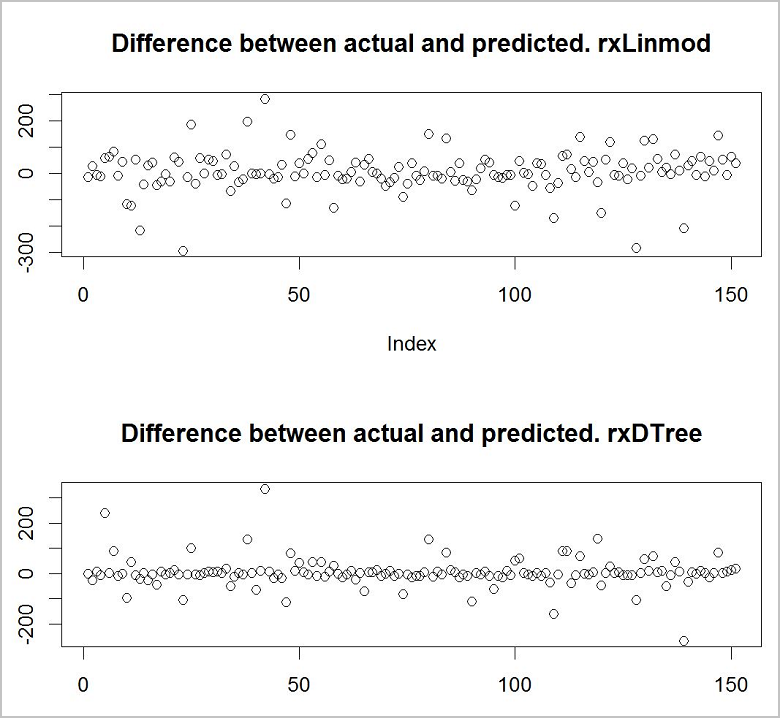Applies to: SQL Server 2016 (13.x) and later
Azure SQL Managed Instance
この 4 部構成のチュートリアル シリーズのパート 3 では、R で予測モデルをトレーニングします。このシリーズの次のパートでは、Machine Learning Services またはビッグ データ クラスターを使用して、このモデルを SQL Server データベースにデプロイします。
この 4 部構成のチュートリアル シリーズのパート 3 では、R で予測モデルをトレーニングします。このシリーズの次のパートでは、Machine Learning Services を使用して、このモデルを SQL Server データベースにデプロイします。
この 4 部構成のチュートリアル シリーズのパート 3 では、R で予測モデルをトレーニングします。このシリーズの次のパートでは、SQL Server R Services を使用して、このモデルをデータベースにデプロイします。
この 4 部構成のチュートリアル シリーズのパート 3 では、R で予測モデルをトレーニングします。このシリーズの次のパートでは、Machine Learning Services を使用して、このモデルを Azure SQL Managed Instance データベースにデプロイします。
この記事では、次の方法について学習します。
- 2 つの機械学習モデルをトレーニングする
- 両方のモデルで予測を行う
- 結果を比較して最も正確なモデルを選択する
In part one, you learned how to restore the sample database.
In part two, you learned how to load the data from a database into a Python data frame and prepare the data in R.
In part four, you'll learn how to store the model in a database, and then create stored procedures from the Python scripts you developed in parts two and three. ストアド プロシージャは、新しいデータに基づいて予測を行うためにサーバーで実行されます。
Prerequisites
Part three of this tutorial series assumes you have fulfilled the prerequisites of part one, and completed the steps in part two.
2 つのモデルをトレーニングする
スキー レンタル データに最適なモデルを見つけるために、2 つの異なるモデル (線形回帰とデシジョン ツリー) を作成し、どちらの予測がより正確であるかを調べます。 このシリーズのパート 1 で作成したデータ フレーム rentaldata を使用します。
#First, split the dataset into two different sets:
# one for training the model and the other for validating it
train_data = rentaldata[rentaldata$Year < 2015,];
test_data = rentaldata[rentaldata$Year == 2015,];
#Use the RentalCount column to check the quality of the prediction against actual values
actual_counts <- test_data$RentalCount;
#Model 1: Use lm to create a linear regression model, trained with the training data set
model_lm <- lm(RentalCount ~ Month + Day + WeekDay + Snow + Holiday, data = train_data);
#Model 2: Use rpart to create a decision tree model, trained with the training data set
library(rpart);
model_rpart <- rpart(RentalCount ~ Month + Day + WeekDay + Snow + Holiday, data = train_data);
両方のモデルで予測を行う
予測関数を使用し、トレーニング済みの各モデルを使ってレンタル数を予測します。
#Use both models to make predictions using the test data set.
predict_lm <- predict(model_lm, test_data)
predict_lm <- data.frame(RentalCount_Pred = predict_lm, RentalCount = test_data$RentalCount,
Year = test_data$Year, Month = test_data$Month,
Day = test_data$Day, Weekday = test_data$WeekDay,
Snow = test_data$Snow, Holiday = test_data$Holiday)
predict_rpart <- predict(model_rpart, test_data)
predict_rpart <- data.frame(RentalCount_Pred = predict_rpart, RentalCount = test_data$RentalCount,
Year = test_data$Year, Month = test_data$Month,
Day = test_data$Day, Weekday = test_data$WeekDay,
Snow = test_data$Snow, Holiday = test_data$Holiday)
#To verify it worked, look at the top rows of the two prediction data sets.
head(predict_lm);
head(predict_rpart);
結果セットは次のとおりです。
RentalCount_Pred RentalCount Month Day WeekDay Snow Holiday
1 27.45858 42 2 11 4 0 0
2 387.29344 360 3 29 1 0 0
3 16.37349 20 4 22 4 0 0
4 31.07058 42 3 6 6 0 0
5 463.97263 405 2 28 7 1 0
6 102.21695 38 1 12 2 1 0
RentalCount_Pred RentalCount Month Day WeekDay Snow Holiday
1 40.0000 42 2 11 4 0 0
2 332.5714 360 3 29 1 0 0
3 27.7500 20 4 22 4 0 0
4 34.2500 42 3 6 6 0 0
5 645.7059 405 2 28 7 1 0
6 40.0000 38 1 12 2 1 0
結果を比較する
次に、どちらのモデルで最善の予測が得られるかを調べます。 これを行うための迅速で簡単な方法は、基本的なプロット関数を使用して、トレーニング データの実際の値と予測値の差を表示することです。
#Use the plotting functionality in R to visualize the results from the predictions
par(mfrow = c(1, 1));
plot(predict_lm$RentalCount_Pred - predict_lm$RentalCount, main = "Difference between actual and predicted. lm")
plot(predict_rpart$RentalCount_Pred - predict_rpart$RentalCount, main = "Difference between actual and predicted. rpart")

2 つのモデルのうち、デシジョン ツリー モデルの方がより正確であるように見えます。
リソースをクリーンアップする
このチュートリアルを続行しない場合は、TutorialDB データベースを削除してください。
Next steps
このチュートリアル シリーズのパート 3 で学習した内容は次のとおりです。
- 2 つの機械学習モデルをトレーニングする
- 両方のモデルで予測を行う
- 結果を比較して最も正確なモデルを選択する
作成した機械学習モデルをデプロイするには、このチュートリアル シリーズのパート 4 の手順に従います。